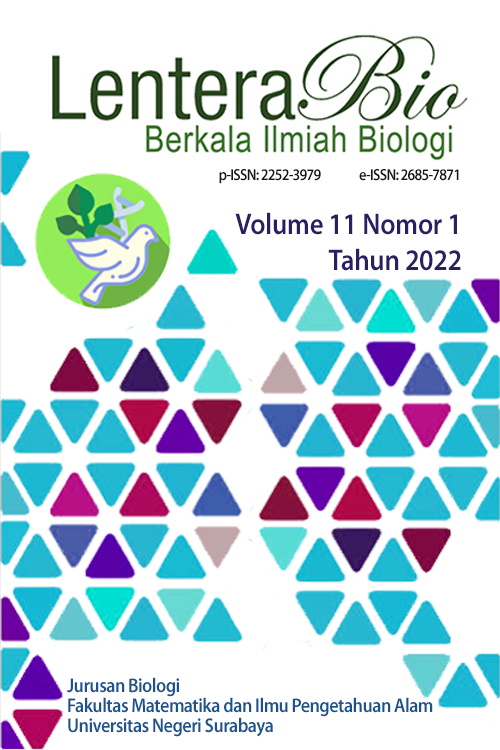Morphogenetic Traits of Cats (Felis domesticus) in Surabaya Ketintang for Selective Breeding as Rodent’s Predator
DOI:
https://doi.org/10.26740/lenterabio.v11n1.p217-225Keywords:
Morphogenetic, Allele frequency, HeterozgosityAbstract
Domestic cat (Felis domesticus) is domestication product of cat that occurred in ancient Egypt as pet or barn guard. This research aims to estimate genetic diversity of cats who lives in Surabaya Ketintang based on morphogenetical caracters expressed by 10 loci such as A~a, B~b~b1, C~cb~cs~ca~c, D~d, I~i, L~l, S~s, T~Ta~tb, W~w, and O⁓o. Research data will be collected by road sampling technique and measured using square root and maximum likehood methods. Cats diversity were represented by the value of heterozygosity and average heterozygosity. 69 samples has been found around Ketintang. Mostly, the wild type has higher frequency than mutant type allele. Locus S⁓s have the highest value of heterozygosity (0.5034±0.0167). Statistical analysis from previous studies have shown that cat behavior and appearance are genetically related. According to the research that has been carried out, it can be estimated that cats who have the O⁓o locus, s allele, A allele, and T~Ta~tb locus are suitable for breeding cats as natural predator of rodents because cats with a combination of those loci tend to be more active, full of curiosity, aggressive towards its prey, in contrast they act calm towards human so they will not cause any harm.
References
Anzila, F., Nopiyanti, N., Febrianti, Y. (2017). Morfogenetik Kucing (Felis domesticus) di Kecamatan Lubuklinggau Utara II Kota Lubukklinggau. Jurusan Biologi STKIP-PGRI Lubuklinggau
Audesirk T, Gerald A, Bruce EB. (2001). Biology : Life on Earth. 6th Ed. New Jersey : Prentice Hall Inc.
Brunberg, E., Gille, S., Mikko, S., Lindgren, G., Keeling, L.J., (2013). Icelandic Horses with the Silver Coat Colour Show Altered Behavior in a Fear Reaction Test. Journal of Applied Animal Behavior. Sci. 146, 72-78.
Christensen, A. C. (2000). Cats as an Aid to Teaching Genetics. Genetics, 155(3), 999-1004.
Endrawati, D. (2005). Studi Identifikasi Golongan Darah dan Kemungkinan Hubungannya dengan Warna Rambut pada Kucing Kampung (Felis familiaris). Bogor: Fakultas Kedokteran Hewan, Institut Pertanian Bogor.
Firdaushi, N. F. (2015). Keanekaragaman Morfogenetik Kucing Domestik (Felis domesticus) di Wilayah Lingkup Kampus IAIN Ambon. Biosel: Biology Science and Education, 4(2), 58-68.
Garcia MR, Alvarez D, Shostell JM. (2005). Population Genetic Analysis of Cats Populations From Mexico, Colombia, Bolivia, and the Dominican Republic: Identification of Different Gene Pools in Latin America. J Genet 84:147-171.
Leslie, A & Lyons. (2008). Feline Coat Color Tests. Veterinary Genetics Laboratory, University of California.
Lesmana, T. (2008). Morfogenetika Kucing (Felis domesticus) di Jakarta Timur. Departemen Biologi Fakultas Matematika dan Ilmu Alam Institut Pertanian Bogor. Hal 1.
Mariandayani, H.N. (2012). Keragaman Kucing Domestic (Felis domesticus) Berdasarkan Morfogenetik. Jurnal peternakan sriwijaya. Vol 1 no 1. Hal. 10,11,3.
Nofisulastri. (2018). Studi Karakter Morfologi Kucing Peranakan Anggora Hasil Perkawinan Silang Alami. Bioscientist : Jurnal Ilmiah Biologi, 6(2), 138-144.
Nofisulastri, N., & Supriadi, S. (2021). Keragaman Ekspresi Lokus Gen Kucing Peranakan Anggora Hasil Perkawinan Silang Alami. Bioscientist: Jurnal Ilmiah Biologi, 9(1), 179-188.
Nozawa, K., Masangkay, J. S., Namikawa, T., Kawamoto, Y., Tanaka, H. (2004). Morphogenetic Traits and Gene Frequencies of The Feral Cats in The Philppines. Rep Soc Res Native Livestock 21:275-295.
Permadi, B., Jayati, R.D., dan Febrianti, Y. (2018). Morfogenetik Kucing (Felis domestius) di Kecamatan Lubuklinggau Utara II Kota Lubuklinggau. Portal MIPA Publisher. STKIP PGRI Lubuklinggau.
Rahman, A. (2008). Morfogenetika Kucing Rumah (Felis domesticus) di Desa Jagobayo Kecamatan Lais Bengkulu Utara Bengkulu. EXACTA, 6(2), 30-41.
Stelow, E. A., Bain, M. J., & Kass, P. H. (2016). The Relationship Between Coat Color and Aggressive Behaviors in the Domestic Cat. Journal of applied animal welfare science, 19(1), 1-15.
Suwed, M. A., & Napitupulu, R. M. (2011). Panduan Lengkap Kucing. Penebar Swadaya Grup.
Trut, L. N., Plyusnina, I. Z., Oskina, I. N. (2004). An Experiment on Fox Domestication and Debatable Issues of Evolution of The Dog. Russ. J. Genet. 40, 644-655.
Wilhelmy, J., Serpell, J., Brown, D., & Siracusa, C. (2016). Behavioral Associations with Breed, Coat Type, and Eye Color in Single-breed Cats. Journal of Veterinary Behavior, 13, 80-87.
Wright, M., Walters, S. (1980). The Book of The Cat. London. Pan Book Ltd.
Downloads
Published
How to Cite
Issue
Section
License
Hak Cipta (c) LenteraBio: Berkala Ilmiah Biologi
Karya ini dilisensikan di bawah Lisensi Internasional Creative Commons Attribution-NonCommercial 4.0.
Pemberitahuan Hak Cipta.
Hak cipta dari artikel yang diterima untuk diterbitkan akan diberikan kepada jurnal sebagai penerbit jurnal. Hak cipta yang dimaksud meliputi hak untuk menerbitkan artikel dalam berbagai bentuk (termasuk cetak ulang). Jurnal mempertahankan hak penerbitan atas artikel yang diterbitkan.
 Abstract views: 1505
,
Abstract views: 1505
, PDF Downloads: 12708
PDF Downloads: 12708











